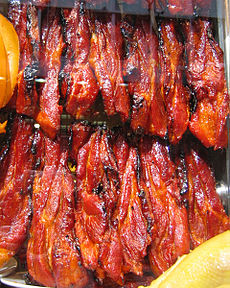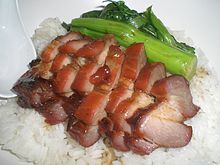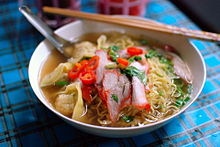- Char siu
-

Charsiu Pork (Chinese-flavored Barbecued Pork)Origin Alternative name(s) chasu, cha siu, chashao, and char siew, barbecued meat Place of origin China Region or state Chinese-speaking areas, Japan, Southeast Asia Dish details Main ingredient(s) Pork, mixture of honey, five-spice powder, fermented tofu (red), dark soy sauce, hoisin sauce, and sherry or rice wine Char siu Chinese name Traditional Chinese 叉燒 Simplified Chinese 叉烧 Cantonese Jyutping caa1 siu1 Hanyu Pinyin chāshāo Literal meaning fork roasted Transcriptions Hakka - Romanization cha seu Mandarin - Hanyu Pinyin chāshāo Min - Hokkien POJ chhe-sio Cantonese (Yue) - Jyutping caa1 siu1 - Yale Romanization cha1 siu1 Indonesian name Indonesian babi panggang merah Japanese name Kanji 叉焼 Kana チャーシュー Transcriptions - Romaji chāshū Thai name Thai หมูแดง RTGS mu daeng Vietnamese name Vietnamese xá xíu Char siu (also spelled chasu, cha siu, chashao, and char siew), otherwise known as barbecued meat (usually pork) in China or Chinese-flavored barbecued meat outside China, is a popular way to flavor and prepare pork in Cantonese cuisine.[1] It is classified as a type of siu mei, Cantonese roasted meat. It is listed at number 28 on World's 50 most delicious foods readers' poll complied by CNN Go in 2011.[2]
Contents
Chinese cuisine
"Char siu" literally means "fork burn/roast" (Char being fork (both noun and verb) and siu being burn/roast) after the traditional cooking method for the dish: long strips of seasoned boneless pork are skewered with long forks and placed in a covered oven or over a fire.
The meat, typically a shoulder cut of domestic pork (although in ancient times wild boar and other available meats were also used), is seasoned with a mixture of honey, five-spice powder, fermented tofu (red), dark soy sauce, hoisin sauce, red food colouring (not a traditional ingredient but very common in today's preparations) and sherry or rice wine (optional). These seasonings turn the exterior layer of the meat dark red, similar to the "smoke ring" of American barbecues. Maltose may be used to give char siu its characteristic shiny glaze.
Char siu is typically consumed with starch, whether inside a bun (cha siu baau), with noodles (cha siu mein), or with rice (cha siu fan) in fast food establishments, or served alone as a centerpiece or main dish in traditional family dining establishments. If it is purchased outside of a restaurant, it is usually taken home and used as one ingredient in various complex entrees consumed at family meals.
Hong Kong
In Hong Kong, char siu is usually purchased from a siu mei establishment, which specializes in meat dishes—char siu pork, soy sauce chicken, white cut chicken, roasted goose, roasted pork, etc. These shops usually display the merchandise by hanging them in the window. As a result, char siu is often consumed alongside one of these other meat dishes when eaten as an independent lunch item on a per-person basis in a "rice box" meal. More commonly it is purchased whole or sliced and wrapped and taken home to be used in family meals either by itself or cooked into one of many vegetable or meat dishes which use char siu pork as an ingredient.
Southeast Asian cuisine
Char siu is often served in a noodle soup as here in Chiang Mai, Thailand
In Malaysia, Singapore, and Thailand, char siew rice is found in many Chinese shāolà (烧腊) stalls along with roasted duck and roasted pork. It is served with slices of char siu, cucumbers, white rice and drenched in sweet gravy or drizzled with dark soy sauce. Char siew rice can also be found in Hainanese chicken rice stalls, where customers have a choice of having their char siew rice served with plain white rice or chicken-flavoured rice, and the same choice of garlic chilli and soy sauces. Char siew is called mu daeng (Thai: หมูแดง; "red pork") in Thailand.
In the Philippines it is know by the name Chinese Asado and usually eaten with cold cuts or served stuffed in siopao.
Vegetarian char siu also exists. It can be found in vegetarian restaurants and stalls in South East Asian Chinese communities.
Japanese cuisine
In Japan, Chāshū, despite its literal meaning of "roasted on a fork", is prepared by rolling the meat into a log and then braising it at a low temperature. The cut used is pork belly rather than shoulder. This results in a softer, moister texture that better complements typical accompaniments such as ramen than roasting would. Chāshū is typically seasoned with honey and soy sauce like its Chinese counterpart, but without the red food colouring, sugar and five-spice powder.
Pacific Rim cuisine
As a means of exceptional flavor and preparation, charsiu's applications extend far beyond pork. In Hawaii, a variety of meats are cooked charsiu style. The term "charsiu" refers to meats which have been marinated in charsiu seasoning prepared either from scratch or from store-bought charsiu seasoning packages, then roasted in an oven or over a fire. Ingredients in marinades for charsiu are similar to those found in China (honey, five-spice, wine, soy, hoisin, etc.), except that red food coloring is often used in place of the red bean curd for convenience. Charsiu is used to marinate and prepare a variety of meats which can either be cooked in a conventional or convection oven (often not requiring the use of a fork or "Cha(zi)" as traditional Chinese ovens do), on a standard Barbecue, or even in an underground Hawaiian imu. In Hawaii, Charsiu chicken is as common as charsiu pork, and a variety of wild birds, mountain goat, and wild boar are also often cooked charsiu style, as are many sausages and skewers.
As charsiu grows in popularity, innovative chefs from around the world, especially chefs from around the Pacific Rim, from Australia to California, are using various meats prepared "charsiu" style in their cuisines and culinary creations.
See also
References
- ^ TVB. "TVB." 廣東菜最具多元烹調方法. Retrieved on 2008-11-19.
- ^ CNN Go Your pick: World's 50 most delicious foods 7 September 2011. Retrieved 2011-10-11
External links
Guangdong topics General Geography Cities • Pearl River mega-city • Leizhou Peninsula • Pearl River Delta • Northern Guangdong • East River • West River • Nanling Mountains • Pratas IslandsEducation Guangzhou Education • Shenzhen Education • Shenzhen University • Huizhou University • Guangdong Institute of Education • Guangzhou UniversityCulture Lingnan culture • Music • Guangdong music (genre) • Cantonese opera • Teochew people • Hakka people • Hailufeng dialectCuisine Cantonese cuisine • White boiled shrimp • Cantonese fried rice • Chinese steamed eggs • Beef chow fun • Chow mein • Char siu • Roasted suckling pig • Bird's nest soup • Seafood birdsnestVisitor attractions Danxia Mountain • Seven Star Crags • Dinghu Mountain • Xinfengjiang Reservoir • Zhongshan Park • Guangdong Provincial MuseumCategories:- Barbecue
- Cantonese cuisine
- Cantonese words and phrases
- Dim sum
- Hawaiian cuisine
- Hong Kong cuisine
- Japanese cuisine
- Malaysian cuisine
- Indonesian Chinese cuisine
- Pork dishes
- Singaporean cuisine
- Skewered foods
Wikimedia Foundation. 2010.



